3D printers, like CNC routers and other machines, have many components and require a fair number of specialized tools and parts to run. By tools, we mean all the additional equipment necessary for your printing process to run smoothly, while spare parts are extras of the parts that can degrade (like nozzles), break, or run out. This equipment is helpful when something goes wrong because, hopefully, you should be able to tackle the problem immediately rather than having to wait until a replacement part or specific tool arrives.
In this article, we’ll go over some great tools and spare parts for your 3D printer. We’ll split our choices into three sections, and for each selection, we’ll go over what it’s for, some examples, and more. Enjoy!
General Tools & Other Equipment
In this section, you’ll find some helpful (and essential) tools and equipment that you’ll want to keep within arm’s reach of your printer!
Air Purifier

Maintaining a clean and healthy environment during your 3D printing projects is essential. The process of melting and extruding filament can release various particles, fumes, and odors into the air, which can be detrimental to our health.
Most traditional air purifiers for rooms will work just fine, but there are options available specifically for 3D printing. For example, you may find some 3D printable options that fit your workspace perfectly or an enclosure for your printer with a built-in air purifier.
Screwdrivers & Hex Keys
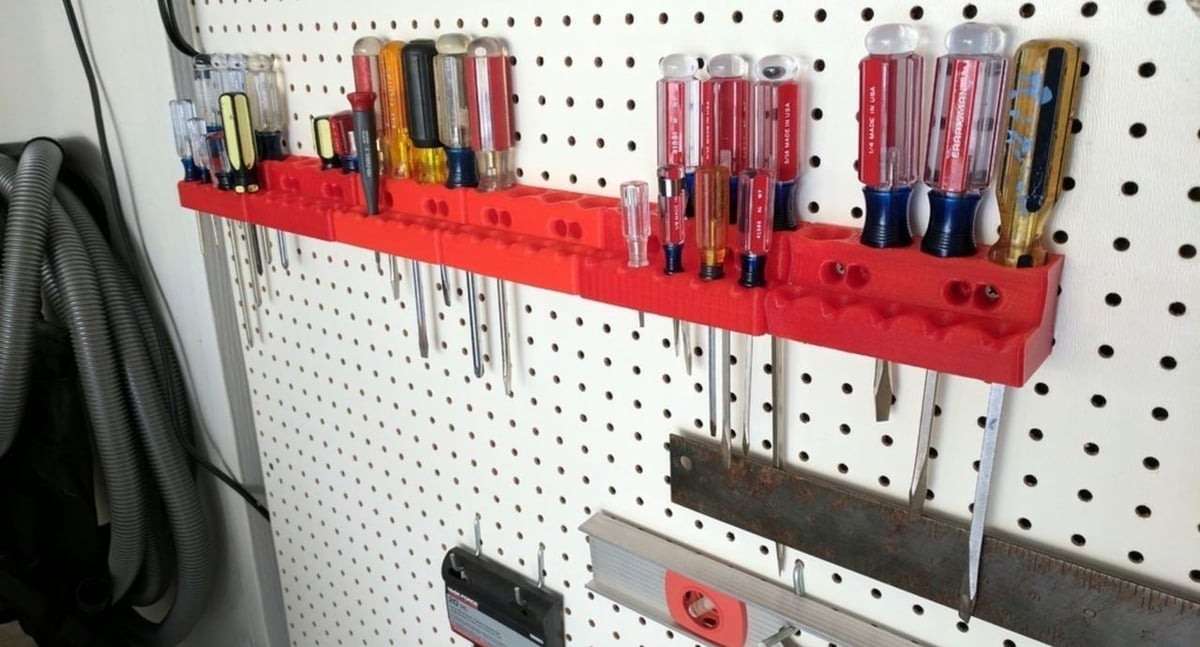
Screwdrivers and hex keys (also known as Allen keys) come with many printer kits and allow you to remove or add parts to your printer. With a set of these tools, you can access certain parts of your printer that may be sealed off with screws, like the mainboard or hot end. These tools are essential to fix almost any part of a machine, including 3D printers, CNC machines, and more.
Hex keys and screwdrivers come in different shapes and sizes, and with different heads, so make sure to get a set with the head and sizing that matches your printer (e.g. hex head, metric). Different brands have different quality toolsets depending on their precision and what material they’re made out of. Some examples of screwdrivers and hex keys include Craftsman’s screwdriver set or Tekton’s Allen key set.
- Price: $15-$50
- Task: Access, add, and remove parts of your printer
- Examples: Craftsman’s screwdriver set, Tekton
Pliers & Tweezers

Pliers and tweezers can help you remove hot items, like a nozzle, and pick out small parts, like a screw from a V-slot extrusion. Pliers are more for grabbing larger items, while tweezers are for smaller items in small or hard-to-reach spaces. Pliers can be used to remove support material from a part, hold hot parts, strip wires, or cut filament.
Pliers and tweezers come in different sizes, styles, and materials. Ones made from stronger materials will last longer and be more durable. For pliers, make sure to choose between large gripped pliers, needle-nose, cutters, other variations, or get a set of them. Some examples of these tool sets include Craftsman’s plier set or this tweezer set.
- Price: $10-$30
- Task: Remove support material, pick up objects, cut filament, cut wires
- Examples: Craftsman plier set, tweezer set
Utility Knife
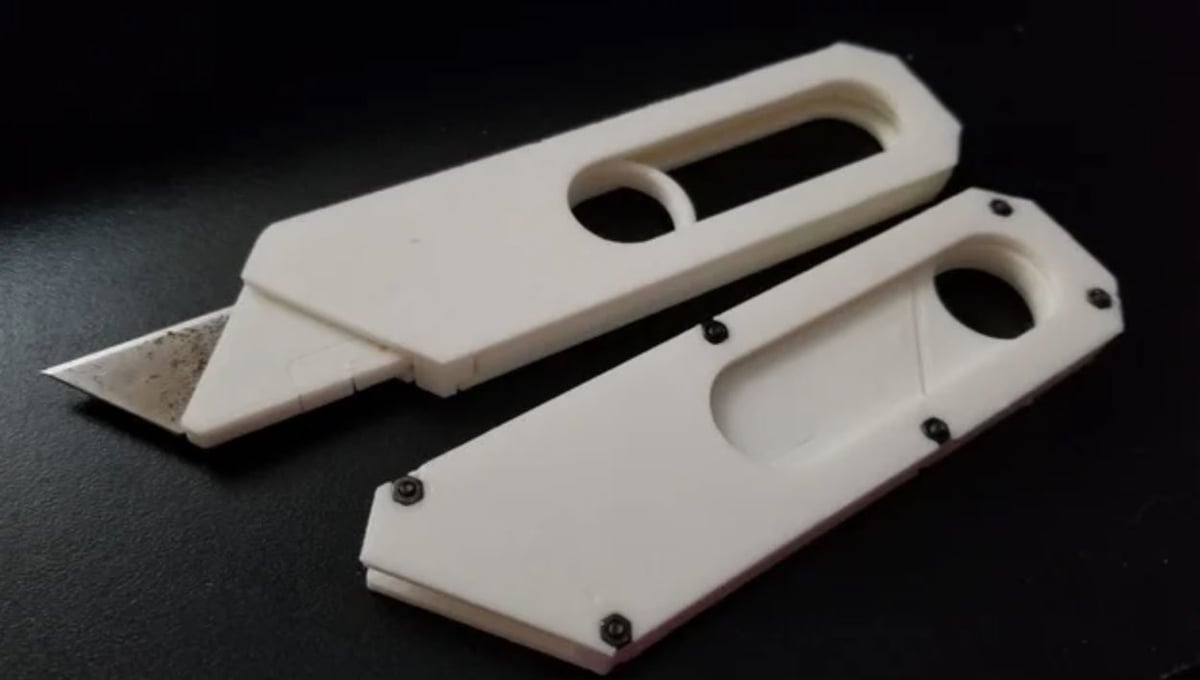
A utility knife is a sharp blade, like an X-Acto knife, that can be used for various tasks, from opening up new boxes of filament to cutting a sharp edge on the filament to load it more easily. Utility knives are also super useful for slicing a PTFE tube evenly by hand (no high points), trimming elephant’s foot on prints, removing supports, and more.
Utility blades can come in individual or multi-pack sets, and their durability can depend on the construction and material of the blade and handle. Two examples of utility knife sets include Craftsman’s utility knife and Workpro’s folding knife set.
- Price: $5-$15
- Task: Open boxes, remove supports, cut tubing, cut filament, remove elephant’s foot
- Examples: Craftsman utility knife, Workpro folding knife set
Flashlight
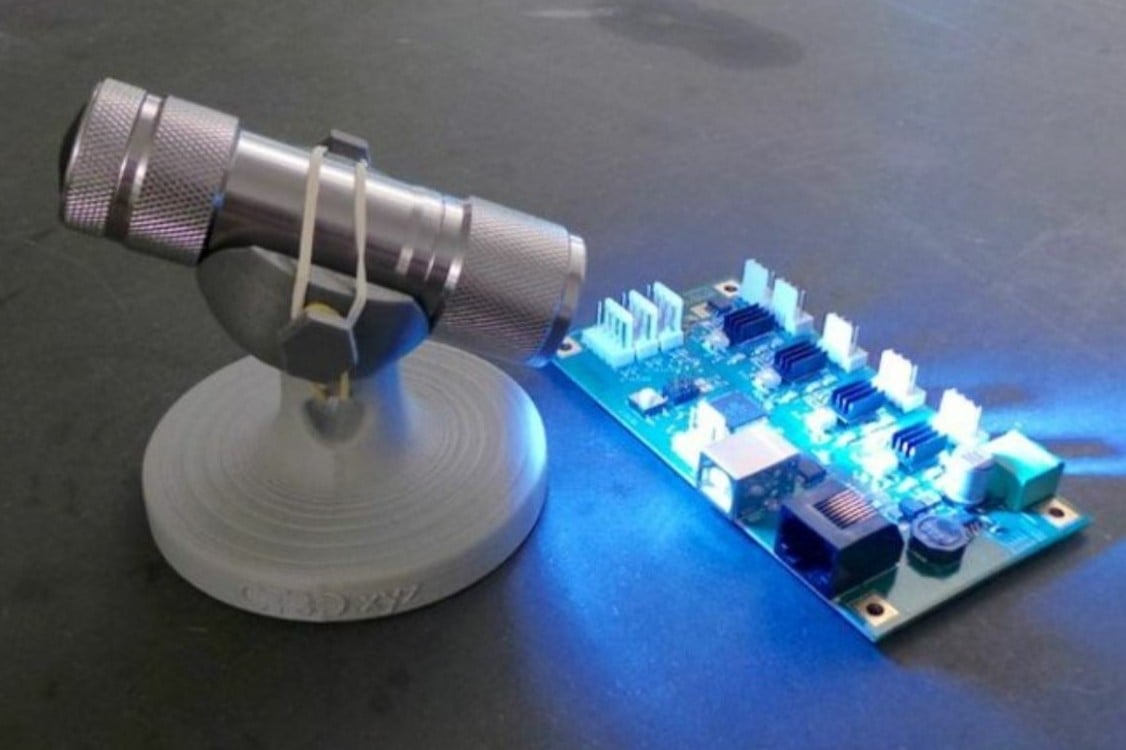
Having proper lighting on and around a 3D printer can be a lifesaver. It makes working with your printer easier because you can see all of its small components better. Additionally, you can watch how your prints progress more clearly. Whether your printer has a lighting system or not, a flashlight is a great tool to have around, as you can use it to illuminate and focus on the small and dark areas of your 3D printer or another assembly.
As you might expect, there are tons of different flashlights to choose from, and you likely already have one that you can use. However, if you don’t have one or want to buy another, there are a few low-cost bright LED flashlight options from Energizer, Vont, and EverBrite.
Digital Caliper
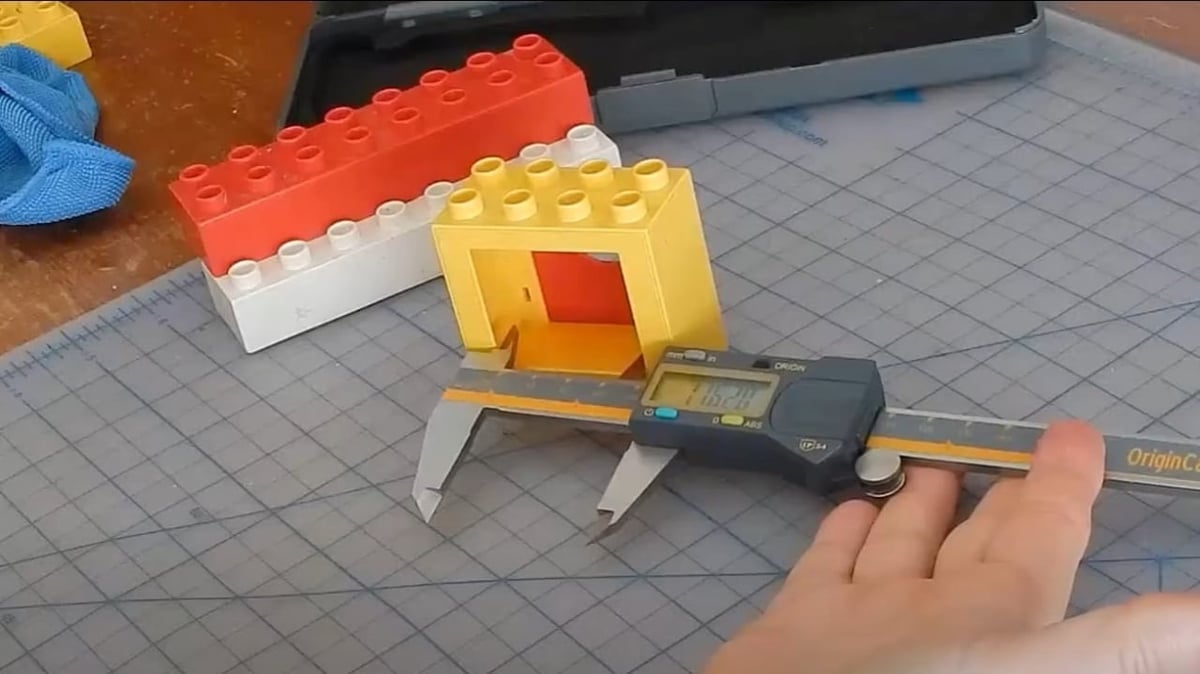
A digital caliper is another great tool to have on hand. It allows you to achieve accurate designs and perform dimensional tests on your printer. This tool is a measuring scale with a digital display for more accurate, less eyeballed measurements. You can use it on your 3D printer to more accurately tune your E-steps and flow settings to prevent over-extrusion or under-extrusion; for designing, you can use it to replicate another part through precise measurements.
Digital calipers range in their quality depending on their tolerance, which is measured in +/- a certain number of millimeters. A caliper’s tolerance reflects its level of accuracy. Digital calipers also come in different materials, and the stiffer, more rigid the material is, the better (metal over plastic). Some excellent examples of digital calipers include Kynup’s durable steel digital caliper and Neiko’s digital caliper.
- Price: $15-$40
- Task: Take measurements for designing, calculate extrusion tests
- Examples: Kynup durable digital caliper, Neiko digital caliper
Rotary Tool
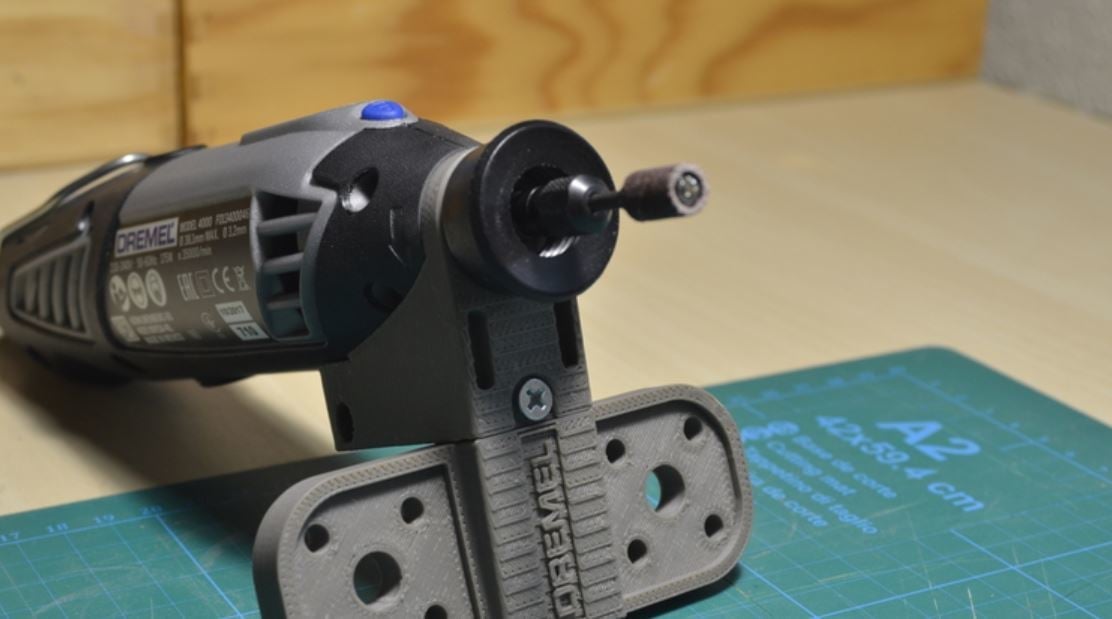
A rotary tool is a bit more expensive than most of the other tools on this list, but it’s super helpful in many scenarios and can be used for various tasks, including cutting, sanding, polishing, drilling, engraving, carving, grinding, sharpening, and more. The tool spins at a usually adjustable RPM so you can use it to modify or finish (sand and polish) your 3D printed parts or, if need be, fix your printer.
Rotary tools vary in quality depending on the reliability, power source, compatible bits, and speeds. Basically, you want a large range of adjustable speeds and a lot of compatible bits so the tool can be used in as many scenarios as possible. The Dremel 4300 is an example of a popular multi-use rotary tool.
- Price: $50-$150
- Task: Modify 3D prints, finish parts, fix printers
- Examples: Dremel 4300
Towels & Wipes
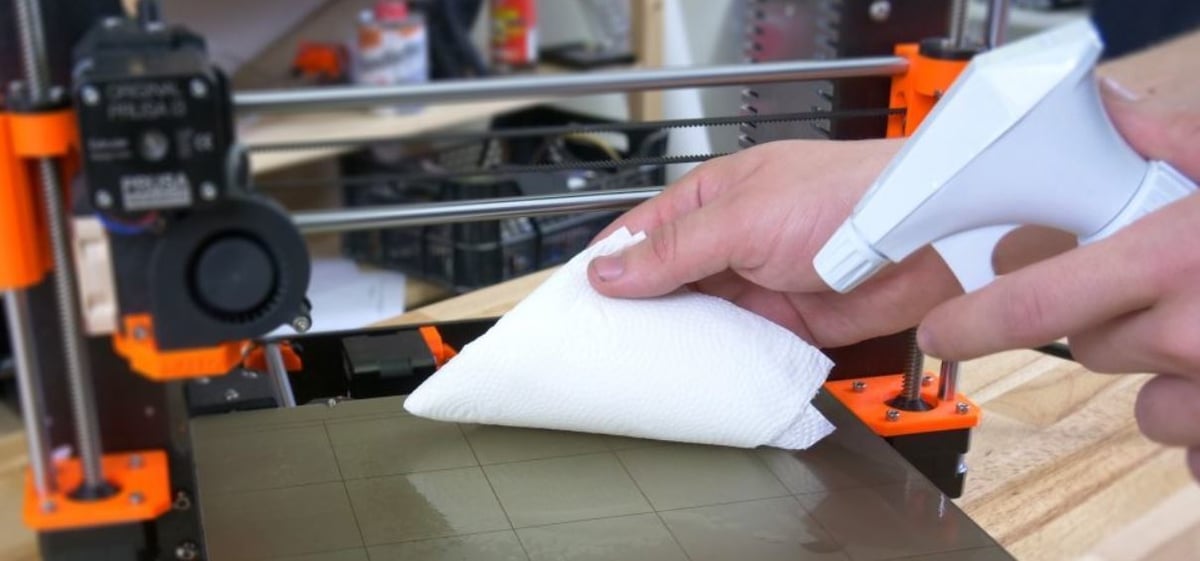
Towels and wipes are a more unexpected selection but are super helpful in many scenarios. You can soak them in water, acetone, or isopropyl alcohol (IPA) and clean your build plate if it’s covered in glue or another residue. Another use for this equipment is cleaning your other tools, hands, or even giving your printer a nice shine to make it look more presentable.
Towels can be anything from an old shirt to a dishrag or a microfiber cloth; microfiber cloths are definitely preferred because they trap dirt and grime. You can use the same cloths meant to clean laptop screens or even the special ones for cleaning musical wind instruments. Examples of microfiber cloths include an Amazon Basics microfiber cloth and MagicFiber’s microfiber cloth.
- Price: $5-$15
- Task: Clean build plate, tools, hands, 3D printer
- Examples: Amazon Basics, MagicFiber
Zip Ties
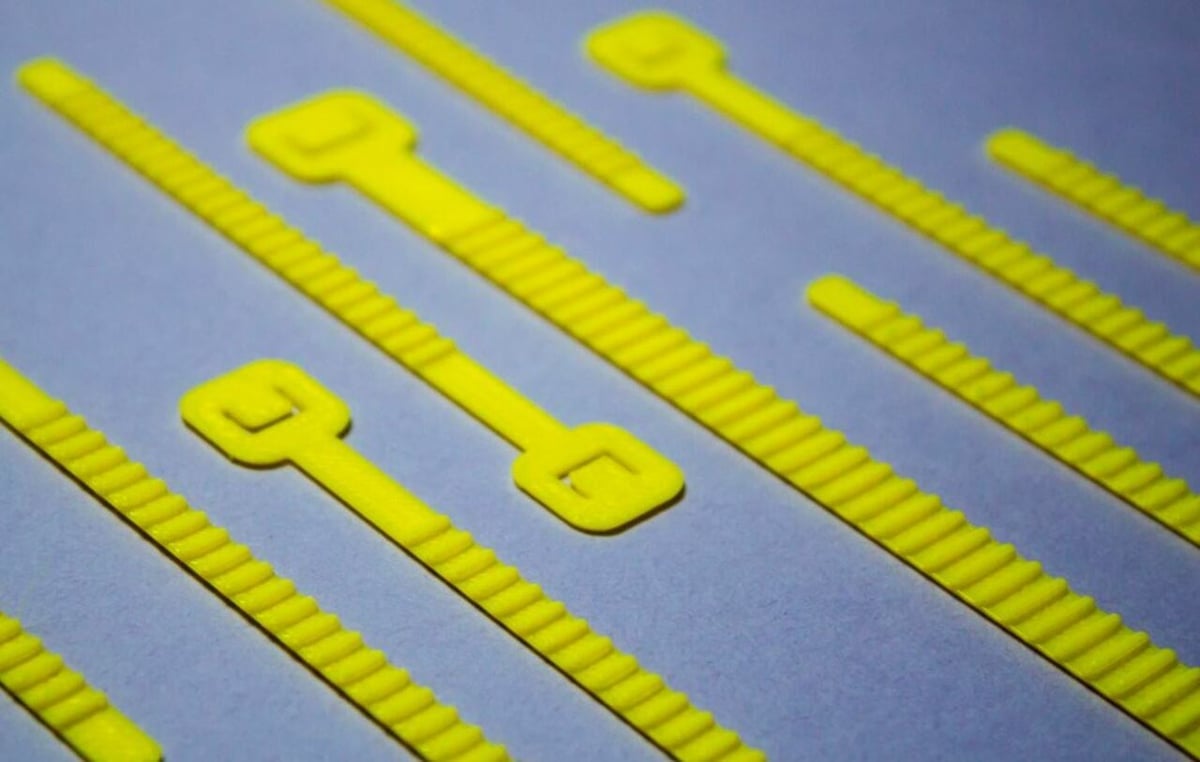
There are many cables that reach from the printer’s motherboard to the different electronic components on the machine. As cable management isn’t always a priority for 3D printer manufacturers, having some zip ties around can always come in handy to ensure that your machine’s wires stay out of the way. If cables aren’t properly managed, they can get caught on the printer’s frame, potentially causing the machine to break or ruin a print.
Zip ties are basically available at every convenience or hardware store, but you can also purchase them online. NewMainOne’s zip tie variety pack is a great choice that contains a few different size options, and there are also many other unbranded options online that are very inexpensive and should work great.
Alternatively, you can even 3D print your own zip ties or similar forms of cable management instruments. Check out our list of 3D printable cable management models to learn more!
- Price: $3-$10
- Task: Organize 3D printer cables and keep wires out of the way
- Examples: NewMainOne, Bolt Dropper, Hmrope
Sandpaper
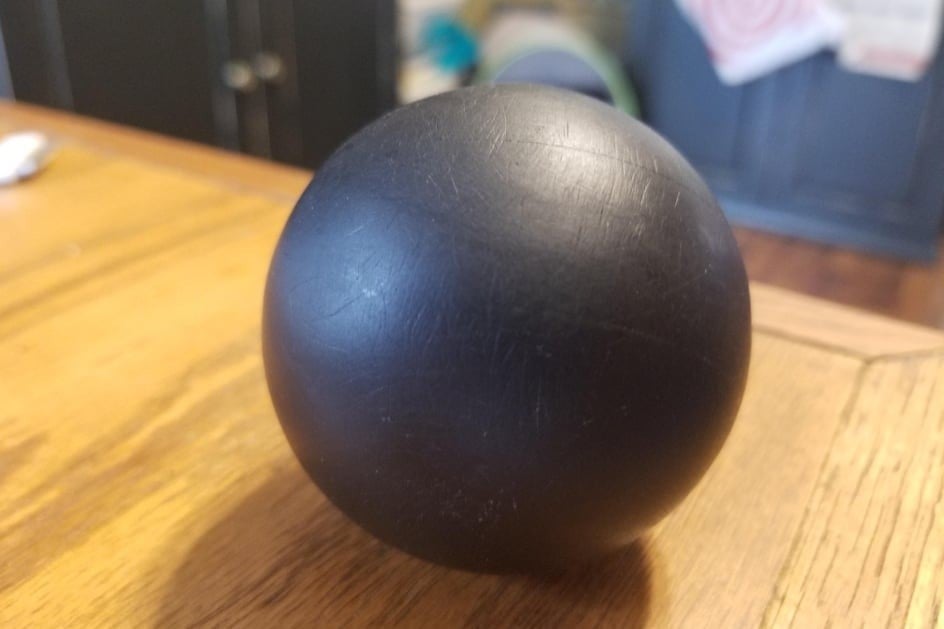
Sandpaper is another piece of 3D printer equipment that is mainly used for post-processing prints. If you’ve ever seen a 3D printed part, you probably remember that distinct layer-line feel to the print due to the FDM printing technology.
You can use sandpaper to blend the different layers of a 3D printed part to hide, both in touch and in appearance, the layer lines on a print. Sanding parts can be used on all types of 3D prints but is especially useful for cosplay or other on-display models.
Sandpaper comes in different grits, and the smaller the grit number, the less smooth the finish is. For 3D prints, you probably want an assortment of different sandpaper with different grit numbers. Atosun’s 120-5000 grit sandpaper set is a good example of a sandpaper set.
- Price: $5-$15
- Task: Smooth and finish prints, hide and blend layer lines
- Examples: Atosun 120-5000 grit
Tools & Accessories for FDM Printers
Print-Removal Blade
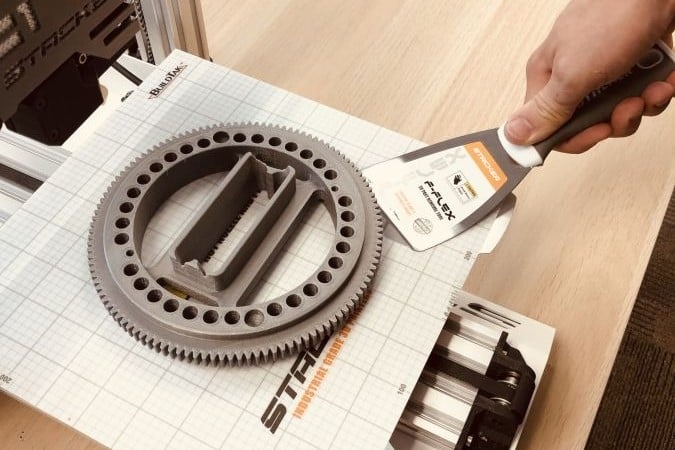
A print removal blade helps you remove prints from your print bed quickly and easily. This tool is especially handy when you use an adhesive on the bed or a filament that sticks very well, like PETG. When using them, the blade should always be pointed away from you as they can be quite sharp!
You can get print removal blades with the handle perpendicular or parallel to the blade. If you don’t want to buy a specific product, using a paint scraper is a DIY alternative that works very well. Examples of this tool include Minatee’s blade or generic brands like Reptor at Amazon.
Glue & Other Adhesives
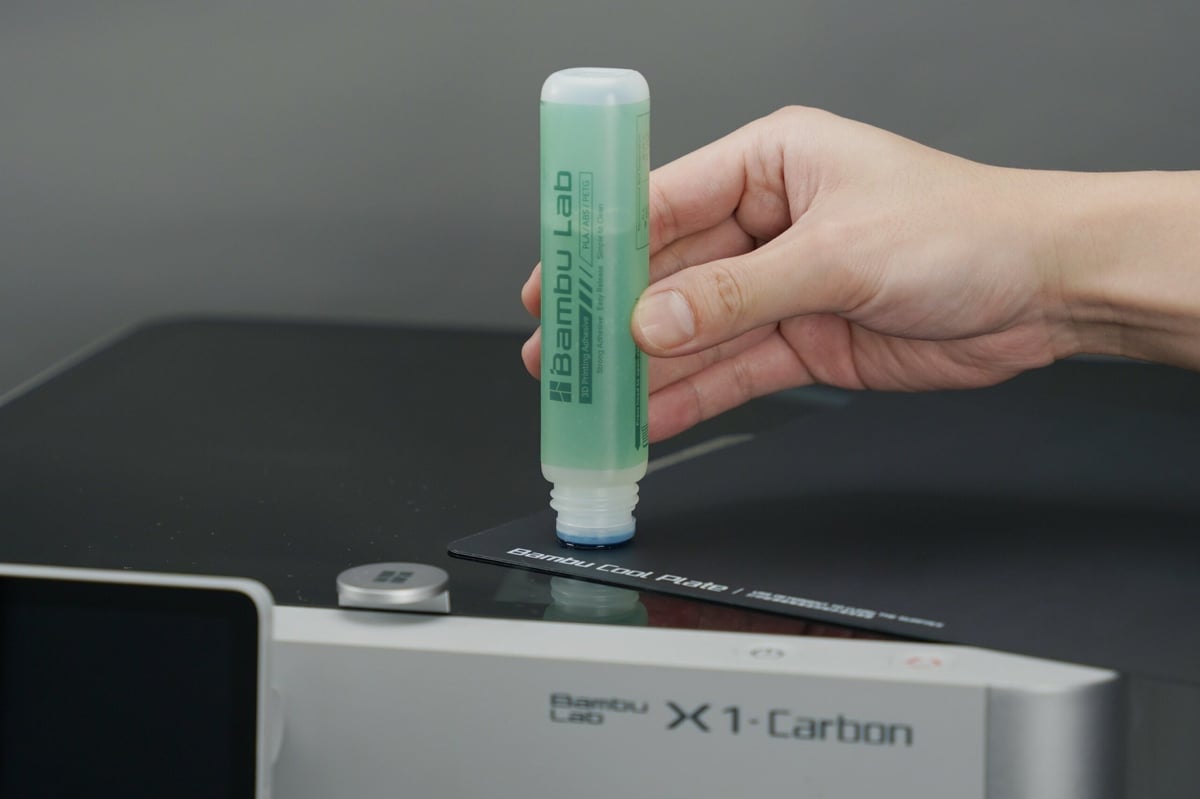
Adhesives are another vital piece of equipment for your FDM 3D printer and can be used in a few different ways. Mainly, adhesives are used to provide improved bed adhesion for 3D prints, but they can also bond different components together.
Glue, hairspray, and other household adhesives are great for providing bed adhesion, and you can find them at home or purchase them for a low cost from most hardware stores or online. Bed adhesives can improve prints by preventing warping and first layer failures, and some examples include Elmer’s glue sticks and L’Oreal hairspray.
Superglue, hot glue, and other more permanent adhesives can bond different 3D printed parts together. This adhesive type is great for making big projects, like a helmet or sword, where multiple prints need to come together. These more permanent adhesives are a little more expensive than basic ones, and some examples include Gorilla Glue and Adtech hot glue sticks.
- Price: $3-$15
- Task: Provide bed adhesion and bond parts
- Examples: Elmer’s glue, Gorilla Glue, Adtech hot glue, L’Oreal hairspray
Soldering Iron

A soldering iron is a great multifunctional addition to your toolset. Of course, you can use a soldering iron and solder to bond wires together, which can be useful in 3D printing projects that use electronic components.
Another use, however, is bonding and smoothing 3D printed models, such as those printed in PLA or PETG.
The heat produced by a soldering iron can be used to iron a surface on a model in order to give it a smooth finish. You can also use the heat to lightly melt the material of two 3D printed parts, then stick them together and let the melted material solidify to bond the two pieces. This especially comes in handy when assembling a multi-part 3D printing project like a large cosplay sword or helmet.
There are many different soldering irons online, and some are higher quality than others, offering more consistent and controllable temperatures as well as coming with extra soldering tips (end pieces). Some examples of soldering irons that would fit a 3D printing purpose are sold by Weller, LDK, and Plusivo.
Nozzle Cleaning Tools
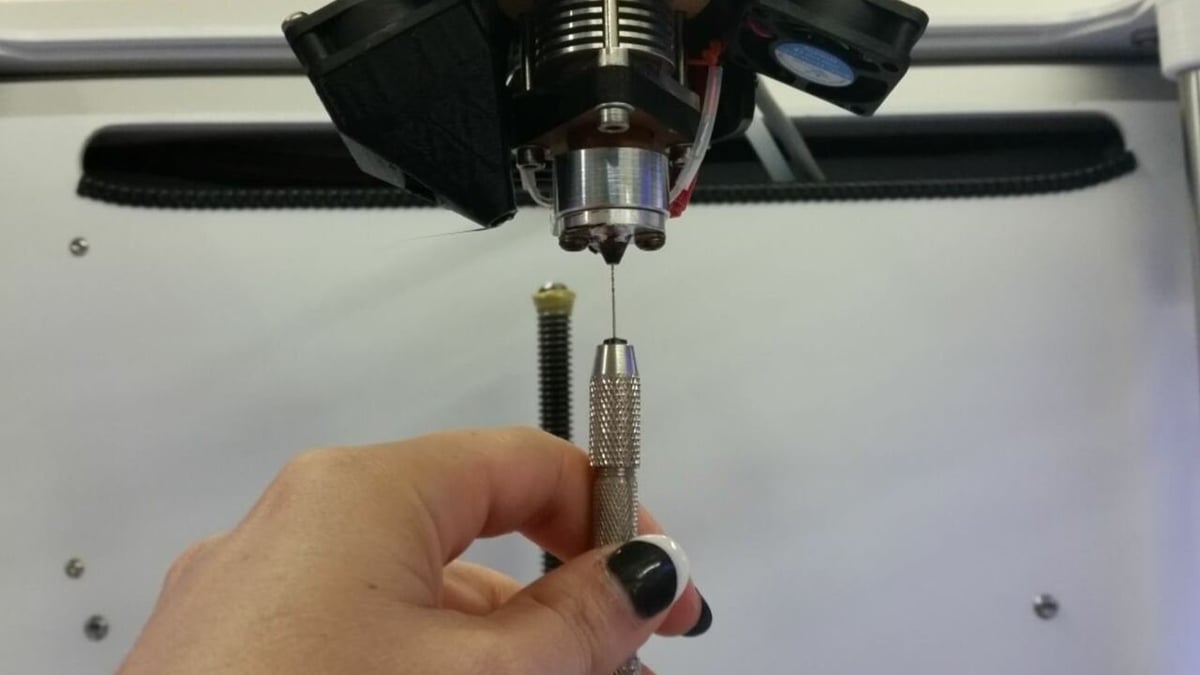
One of the most common causes of print quality issues is a clogged nozzle. Debris around the nozzle’s exit hole prevents filament from properly extruding, yielding bad prints. Nozzle cleaning tools come in a few variations and can help remove debris from the nozzle.
The most popular nozzle cleaning tool is a needle. While the nozzle’s heated, you can use the needle to push away or pierce through any debris in the nozzle. These needles have to be pretty thin to fit inside the nozzle hole, and they tend to bend and kink easily, which is why we suggest having a few of these on hand.
Another useful nozzle cleaning tool to have around is a wire brush, which is basically a mini toothbrush with rigid wire bristles that you can use to remove debris from the exterior of the nozzle. While this isn’t technically the same as removing internal debris on the nozzle, unwanted and excess substances on the outside of your nozzle can also cause extrusion issues.
As you probably want a few different types of nozzle cleaning tools and multiple of each one, we suggest purchasing a nozzle cleaning kit. These kits are offered by a few brands. Examples include Frienda’s 40-piece, Siquk’s 33-piece, and Kitanis’ 12-piece kits.
Stepper Motor Vibration Dampeners
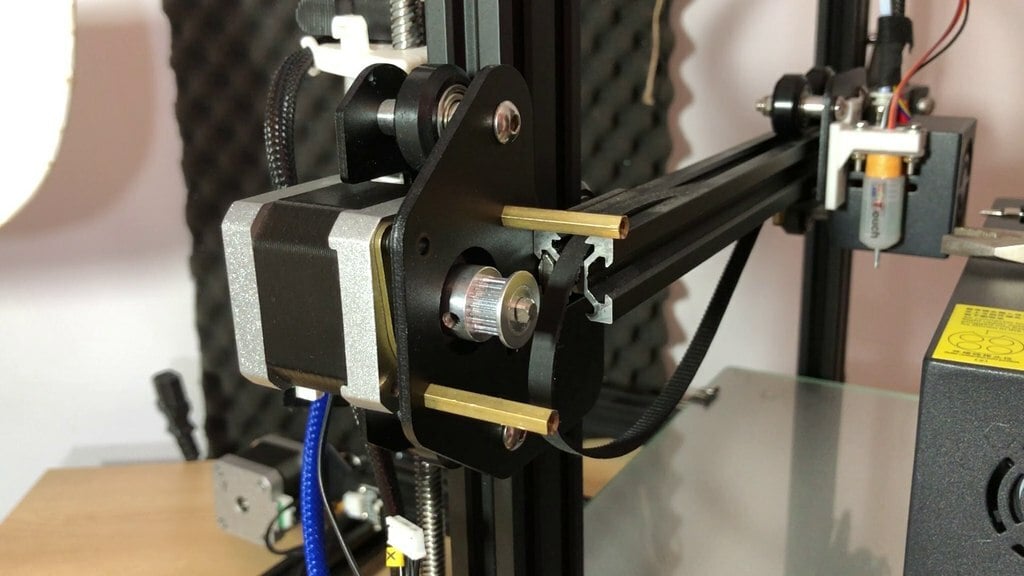
Stepper motors are an essential component in 3D printers, responsible for precise and controlled movements. However, these motors can produce vibrations during operation, leading to unwanted artifacts and reduced print quality. That’s where stepper motor vibration dampeners come into play. These accessories are designed to minimize the vibrations generated by the stepper motors, resulting in smoother and more accurate prints.
While there are variations in design and compatibility, stepper motor vibration dampeners are commonly available as pre-cut pads or complete dampening kits. Pre-cut pads are ideal for users who prefer a DIY approach and want to experiment with different placement options. On the other hand, complete dampening kits often include specially designed mounts and brackets for easy installation. These kits may offer additional features such as adjustable tension and compatibility with various stepper motor sizes.
- Price: $5-$15
- Task: Reduce vibrations from the stepper motors
- Examples: Biqu, Bigtreetech
Painter's Tape
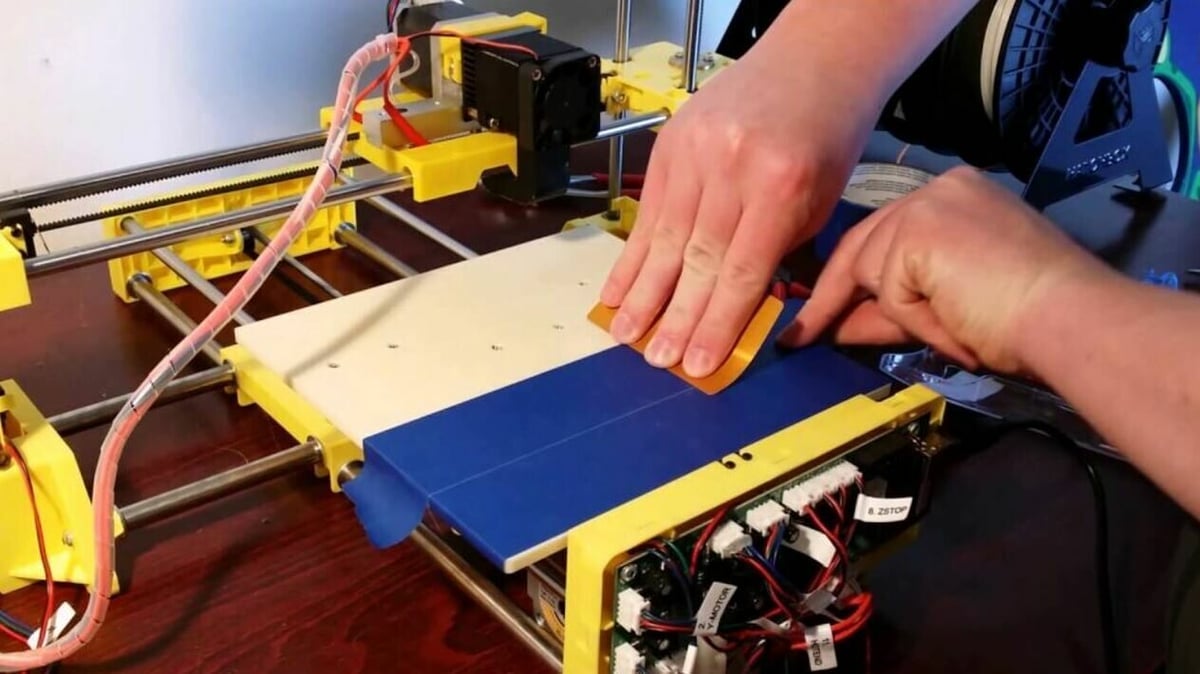
Getting the first layer of prints to stick to the print surface can be a difficult task, especially if your print bed is deformed or bent. Painter’s tape is a common low-cost solution to bed adhesion issues, and you can apply the tape over your existing print bed as melted filament typically easily adheres to the tape. As the tape is removable and temporary, you can also add an additional adhesive substance like glue over the tape!
While regular painter’s tape (in spools) works, for a smoother print surface, you can purchase sheets of this tape meant for 3D printing that will fit your print bed. Some specific examples of this type of tape are Olycraft tape sheets and Duck Brand tape spools. No matter what brand of tape you choose, when applying it to your print bed, make sure to use a thin, stiff tool like a credit card to ensure that there are no air bubbles on the strip or sheet of tape.
- Price: $5-$15
- Task: Provides a temporary and removable print surface that filament sticks to easily
- Examples: Olycraft tape sheets, Duck Brand tape spools
Filament Storage

Proper filament storage is crucial for maintaining the quality and performance of your 3D printing materials. Filament storage solutions typically come in the form of filament dry boxes or containers that provide a controlled environment for storing filament spools. These storage units are designed to maintain low humidity levels, preventing moisture absorption and preserving the filament’s integrity.
Other options include filament storage containers, which are designed to hold multiple filament spools in one convenient place, and vacuum storage bags. These devices are used to vacuum-seal filament spools, removing air and moisture. Vacuum-sealed spools can be stored in regular containers or boxes, providing an additional layer of protection.
You can also make use of desiccant packs, which are small packets containing moisture-absorbing materials, such as silica gel. They can be placed alongside filament spools in storage containers to help keep humidity levels low.
Spare Parts for FDM Printers
In this section, you’ll find some great spare parts and accessories. This is stuff that you’ll be glad to have on hand in the event that something goes wrong!
Filament

As you probably know, filament is the food of FDM 3D printers and, if you’re into 3D printing a lot, you may run out of it a lot. Filament comes in different materials, colors, diameters, finishes, tolerances, brands, and more. Since filament is usually single-colored (though there are some rainbow options), having a few spools of the same materials in different colors, or different materials altogether, is a great idea.
Even if you have just one 3D printer, building up a collection of filaments is a great way to open the doors to completing more projects that require different parts (flexible, stiff, and even carbon-fiber reinforced). Most people use PLA filament for its ease of use, but you should get some more filament to widen your collection if you want other colors or different materials. Some examples of PLA filament include Hatchbox’s or Sunlu’s.
- Price: $17-$25
- Task: 3D print stuff
- Examples: Hatchbox PLA, Sunlu PLA
Nozzles
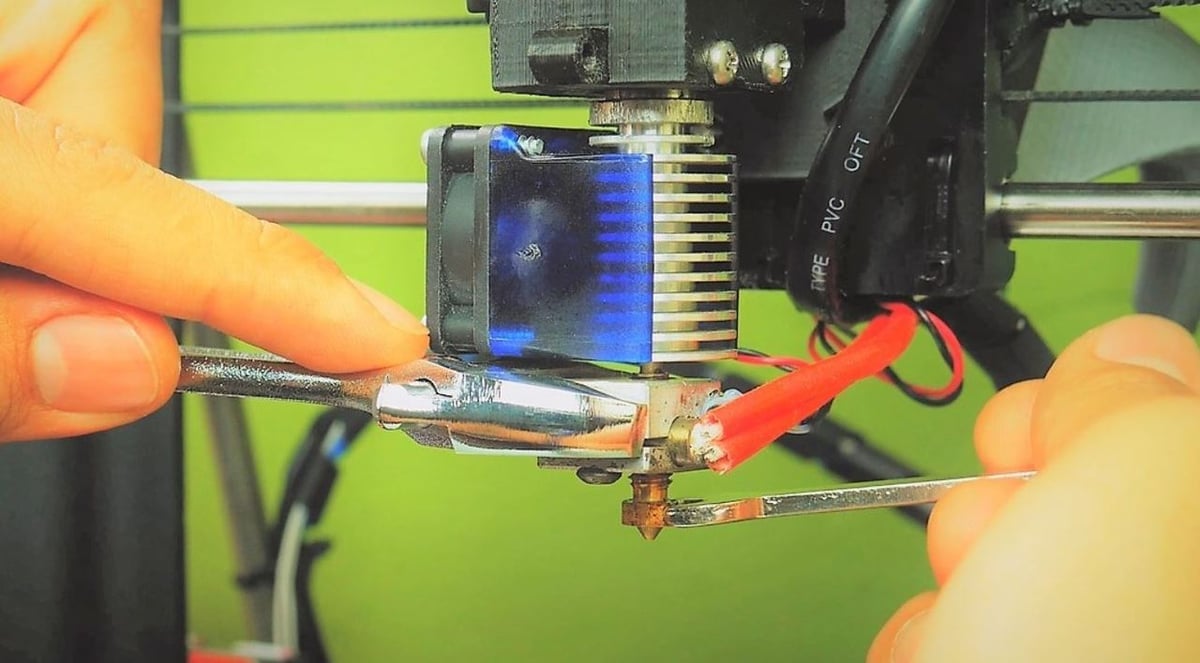
Nozzles are the tip of an FDM 3D printer’s hot end and are where the melted filament comes out. Nozzles can abrade and degrade over time, which will lead to inconsistent extrusion, so it’s important to have some spares in case of jamming or clogging. Nozzles come in different materials, including brass, steel, tungsten, and ruby-tipped; the more conductive, abrasion-resistant, and hard the nozzle is, the better.
Nozzles have differences in quality depending on the quality of the material they’re made of. The most common material for nozzles is brass, and examples of this type of nozzle include E3D’s V6 nozzle and Tuparka’s nozzle set.
- Price: $2-$20
- Task: Provide consistent extrusion to 3D print filament
- Examples: E3D V6, Tuparka
Hot End
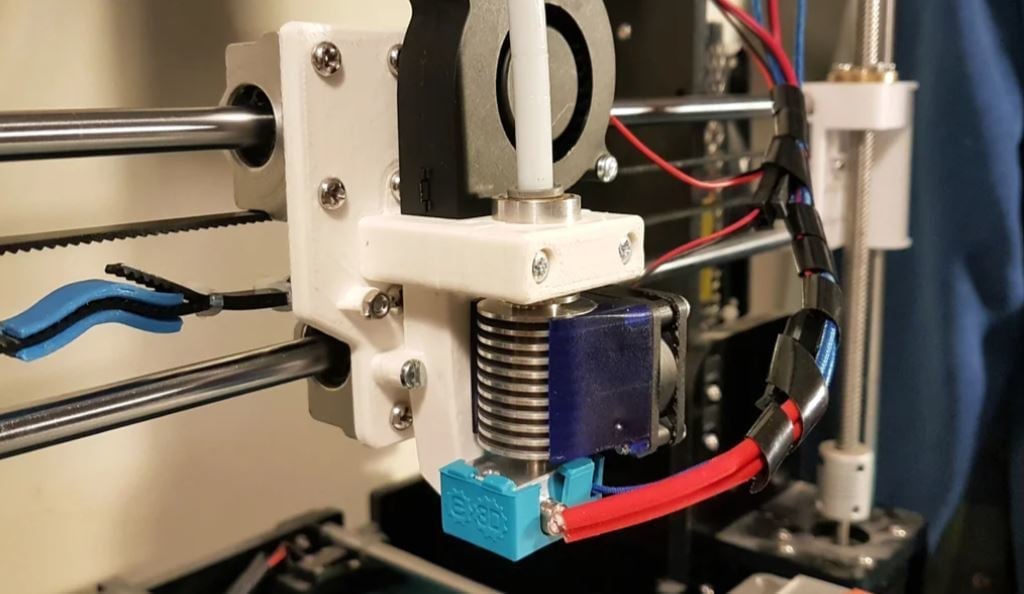
While hot ends (the heating component) don’t frequently break, it’s worth having a spare or two on hand. If one gets clogged or needs a repair, you may want a quick replacement if you’re running a tight schedule for printing. Another reason you may want an extra is if you don’t want to deal with the hassle of fixing them, which can be especially difficult on proprietary printers.
Hot ends come in many variations, and the quality of a hot end depends on a few things. Mainly, a better hot end will use higher-end (more heat-resistant) materials with a well-designed heat sink, and more. Some common examples of hot ends include the Creality hot end or the E3D V6 hot end.
- Price: $15-$75
- Task: Heat up filament
- Examples: Creality, E3D V6
PTFE Tube & Couplers
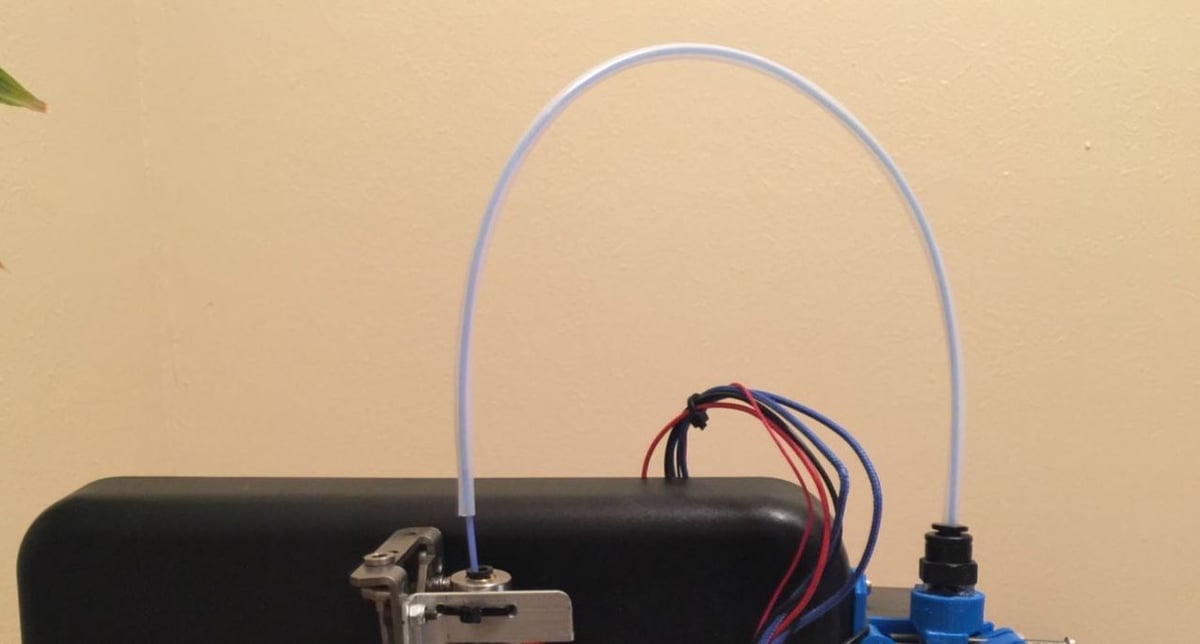
A PTFE tube is Teflon tubing that’s included in most extruder setups, whether Bowden or direct drive. PTFE tubes are connected to the hot end and extruder via a PTFE coupler, and filament travels through the tube. These parts can wear over time, and you may want to replace them after a while, especially if your couplers have a weak spring or the tube is scorched on the hot end side.
PTFE tubes and couplers come in different sizes for the filament’s diameter, but most commonly, they are designed for 1.75-mm filament. Some great options are Capricorn’s high-quality tubing and couplers or AMX3D’s tubing.
- Price: $5-$20
- Task: Protect and transport filament from the extruder to the hot end
- Examples: Capricorn, AMX3D
Build Plates
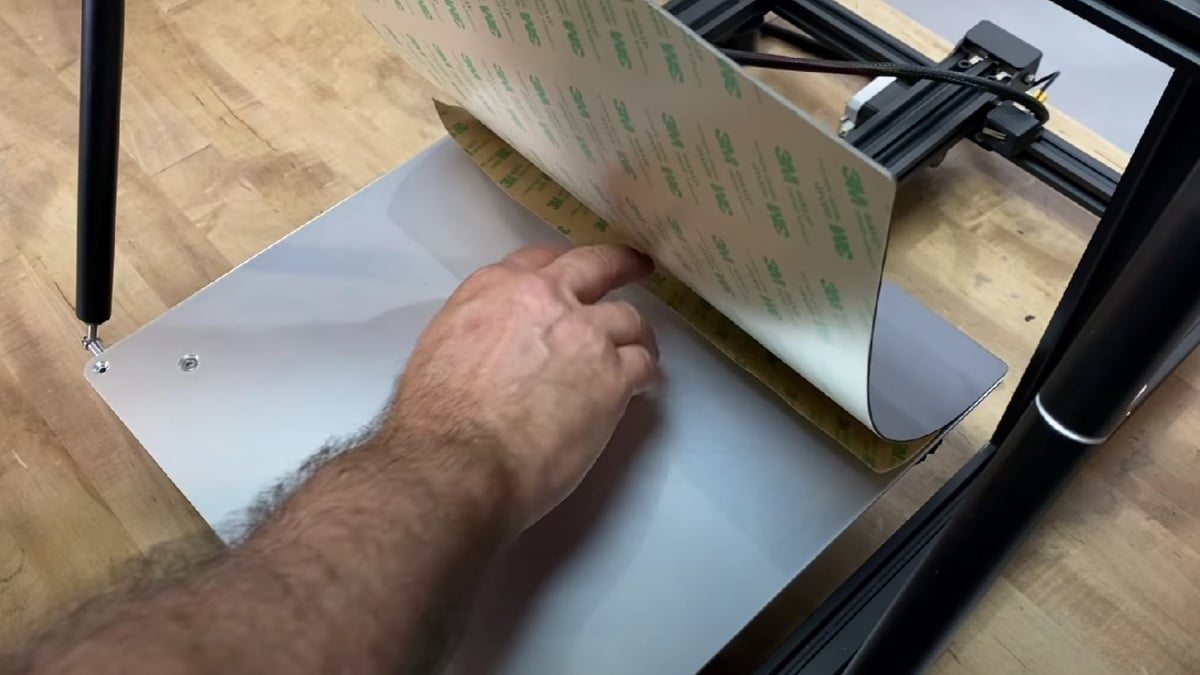
The build plate is the uppermost surface on your printer on which parts are printed. Build plates come in different materials like glass and steel, and some plates have special features like being magnetic or flexible. If your build plate becomes cracked, bent, or warped, you may want to replace it because it can make bed leveling difficult.
Build plates don’t vary too much in quality, but, as we said, they come in different materials with different features. Better build plates provide better adhesion for the filament to be laid out and printed; two good options are a tempered glass bed and a flexible steel bed. Examples of these beds are Creality’s tempered glass plate and Hictop’s PEI spring steel magnetic bed.
- Price: $20-$50
- Task: Gives filament a sticky surface to be laid out on
- Examples: Creality, Hictop
Wires & Cables
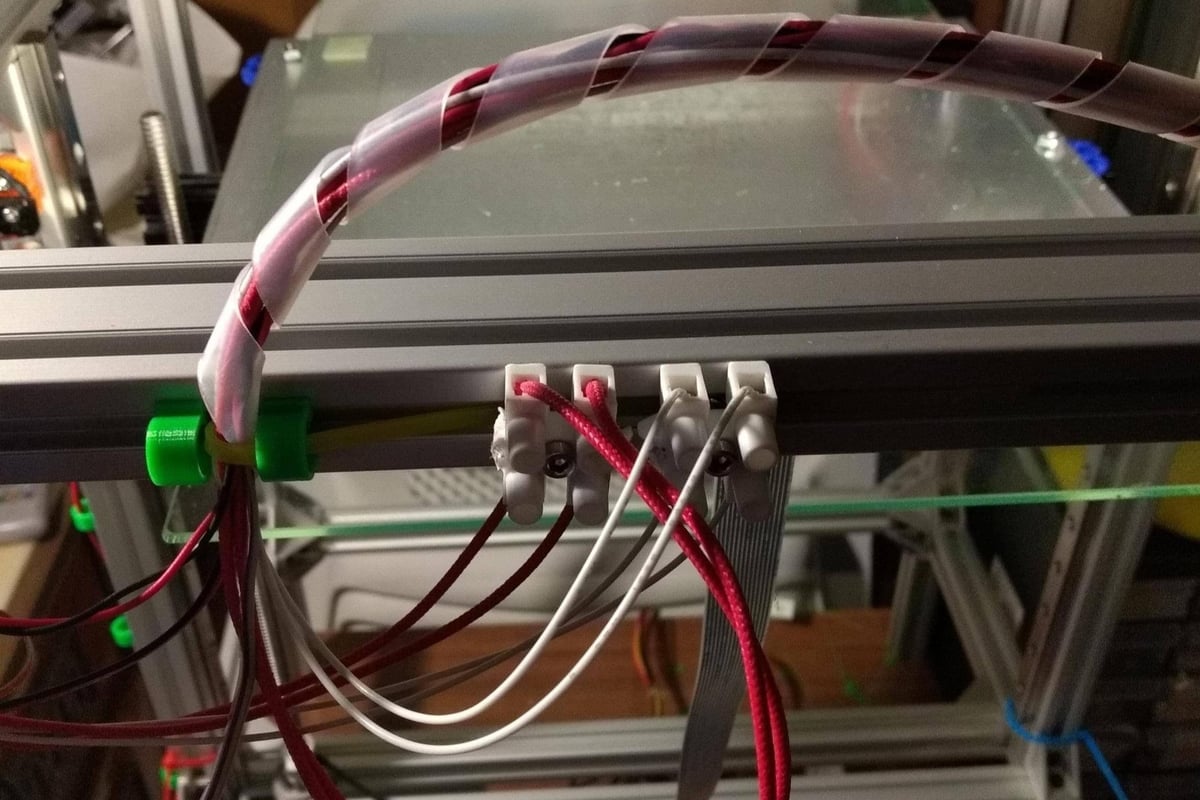
Wires can eventually break due to wear and tear, so you may want to have some spare wiring on hand for your machines. Especially on machines like 3D printers with lots of moving parts, wires can degrade due to friction or if they’re stretched or squeezed too hard. You may also want extra wires if you plan to do small projects in your workspace (like with an SBC).
Wires can vary in gauge (thickness), but the quality shouldn’t change too much based on the brand. For choosing which gauge, you might want spares of certain 3D printer wires, such as the ones for your heater, thermistor, and stepper motors. A great example is Ueetek’s stepper motor cables.
- Price: $10-$20
- Task: Transport power to certain parts of your printer
- Examples: Ueetek’s stepper motor cables
Tools & Accessories for Resin Printers
Up next, we have some tools specific to resin 3D printing.
Rollers
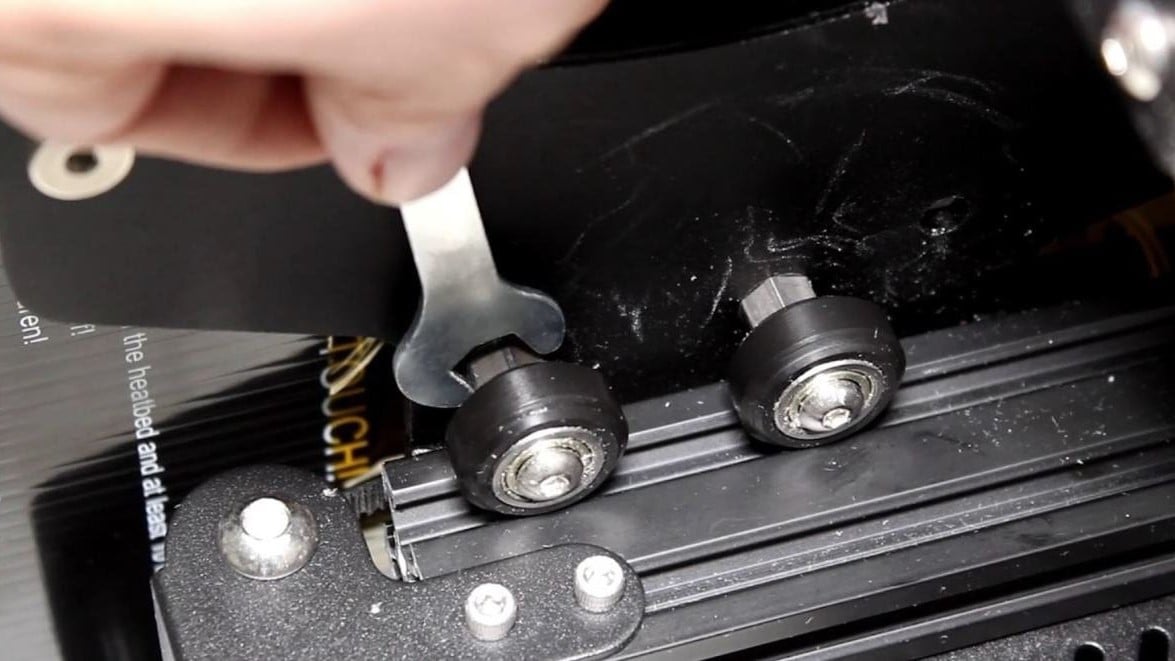
Rollers are commonly used on printers, like the Ender 3 or Artillery Sidewinder X1, that use V-slot extrusions to move on the X-, Y-, or Z-axis. Rollers are bearings with wheels on the outside that are supposed to provide smooth motion on the axis they are used on.
As you might expect, many 3D printer manufacturers use cheap plastics for these wheels, which can degrade very fast, making the motion rougher and decreasing the print quality. For this reason, you may want to keep some spare rollers around.
Usually, three or four are used on each axis, so it’s good to have a backup supply. When choosing which ones to get, focus on quality over price, and look for positive reviews. An example is Aokin’s rollers, which has pretty good reviews.
- Price: $5-$15
- Task: Move your printer’s axes smoothly
- Examples: Aokin
Belts
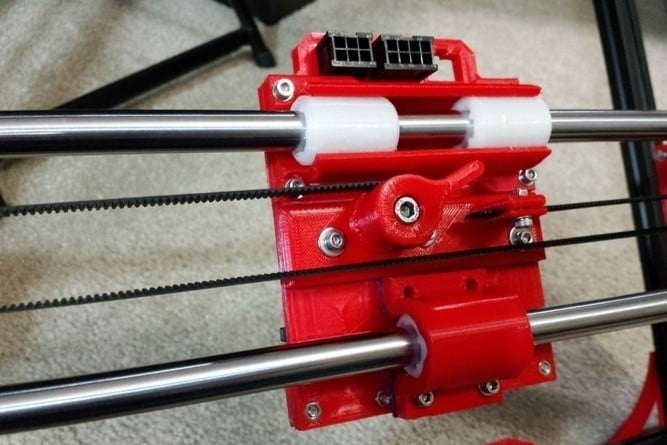
Lastly, belts are used on most 3D printers on the X- and Y-axes and are connected to the carriage and stepper motor. Belts, especially when over-tightened, can wear, and many 3D printer manufacturers use cheap belts that aren’t known for lasting long with frequent use. You may want to keep some spare belts around for replacing your old ones on your 3D printer every so often.
Belts come in different sizes and for different purposes. For many 3D printers, a G2 timing belt works great, and when purchasing them, you should try to get a roll of belt lining with end ties. Some good examples include Creality’s timing belt and Zeelo’s timing belt with fastener end ties.
- Price: $10-$15
- Task: Connect your axis carriage to your stepper motor so it can move
- Examples: Creality’s timing belt, Zeelo
Resin Filter with Screen

This tool is a great upgrade for your resin vat drainer. Most resin 3D printers come with paper filters for draining resin back into the bottle without letting cured pieces inside. While these paper filters are great, they can add up and create a lot of waste. Eliminate the need to throw away your filters with a metal funnel, complete with a removable filter screen. This tool also makes cleanup a breeze.
If you would like to try one out before purchasing a metal funnel, you can 3D print a resin filter with a screen. It offers the same functionality and can be sized to fit any bottles you plan to use.
- Price: ~$9
- Task: Filter cured resin and debris from entering resin bottles
- Example: Gnellkoor Resin Filter Funnel
Adjustable Vat Drainer
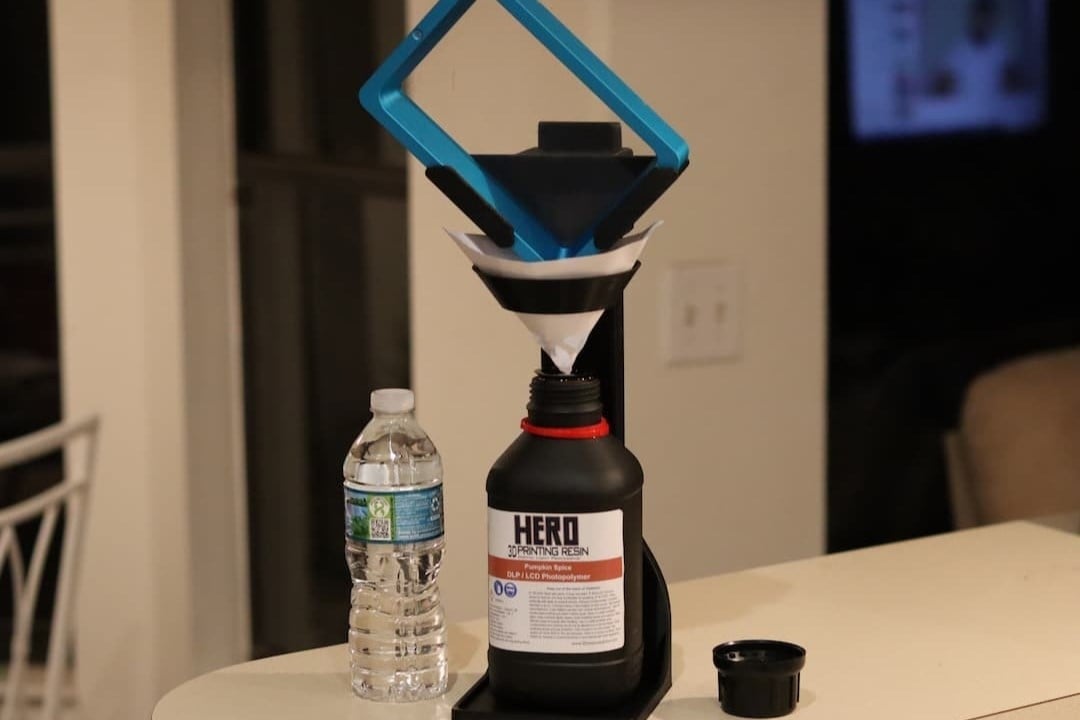
If you own a resin 3D printer, you know just how tedious it can be to prepare your printer and clean up in between prints. One of the most time-consuming parts is having to hold your resin vat over a filter while it drains back into the bottle. This tool will automate the process and free up your hands, so you can get everything done more quickly.
Most standard resin printing vats will fit in the resting bracket except for some of the larger models. This tool also comes with a funnel that features a filter screen to trap any cured bits of resin before they enter the bottle. The height of the vat arms can be adjusted to accommodate any size of resin bottle you use.
If you are into DIY or aren’t ready to spend so much on this type of tool, there’s a great 3D printable Resin Vat Drainer on Thingiverse by MakerMatrix.
- Price: ~$73
- Task: Hands-free method for draining resin vat to prepare for a different color or resin type
- Example: OTURGC Vat Scraper
Tank Cover

Many makers have long periods where their resin prints are not in use while they plan out their next big project. During this time, you’ll want to keep your vats from collecting dust or accidentally curing in the sun. This is where a vat resin cover comes in handy.
A resin vat cover is nice to have around, especially if you’re the type to leave the protective covers off of your resin 3D printers. Pet owners and parents will feel much safer with their vats fully enclosed so no accidents can happen.
While silicone covers will give you the best fit, you can 3D print your own if you’re in a hurry. This Elegoo resin tank cover is perfectly sized for an Anycubic Photon printer. Darker filament covers are recommended to block as much light leak as possible.
- Price: ~$10
- Task: Cover the resin vat when not in use to protect it from dirt, dust, and UV rays
- Example: Elegoo Tank Cover
Vat Scraper

While most resin printers these days will come with a scraper of some kind, they can sometimes leave a lot to be desired. Having a good, high-quality resin vat scraper is a must for getting your vat completely clean in between uses.
Metal scrapers aren’t recommended, as they can potentially scratch or tear the vat. Plastic scrapers are the safest and will still provide all the utility you need. There are 3D printable resin vat scrapers out there, and it’s best to print them in a flexible material like TPU to prevent damage to the FEP sheet.
- Price: ~$8
- Task: Safely remove resin from the vat without damaging the FEP sheet
- Example: Oturgc Vat Scraper
Curing Chamber

Every resin printer owner needs a way to cure their prints once they’re off the print bed. While you could always leave them in the sun to cure, nothing beats having a dedicated curing chamber. The consistency and reliability of a resin cure chamber make it worth every penny. A quality curing chamber will automatically rotate your prints and give them an even cure on all sides after only a few minutes.
There are plenty of DIY options available, such as this Resin Cure Chamber. Some options are entirely made of 3D printed parts, aside from the required UV lights. This type is best for users who need a curing station in a specific size, as you can scale it to your needs.
- Price: ~$100
- Task: Cure resin prints to harden them and make them safe to touch
- Example: Anycubic Wash and Cure
License: The text of "3D Printing Tools & Parts: 30 Useful Accessories for 2024" by All3DP is licensed under a Creative Commons Attribution 4.0 International License.





